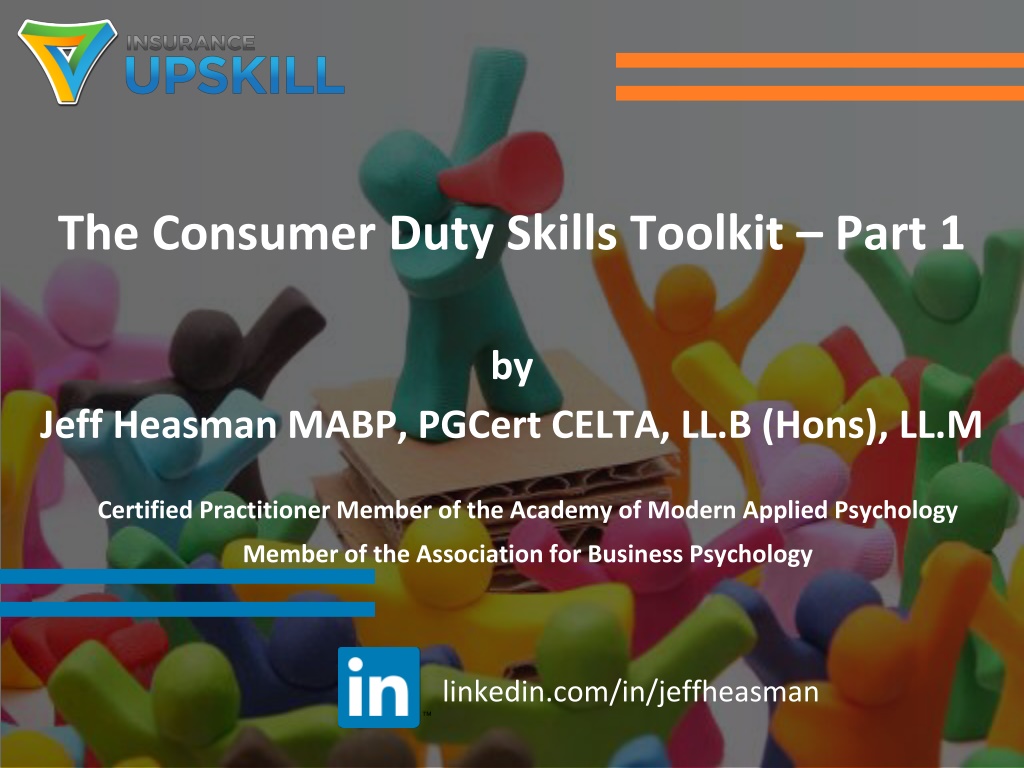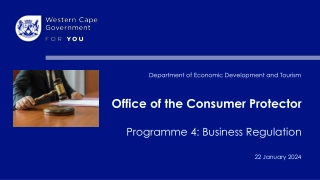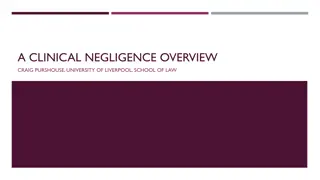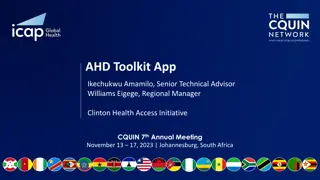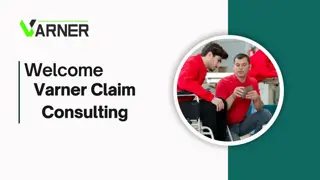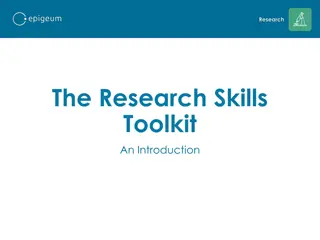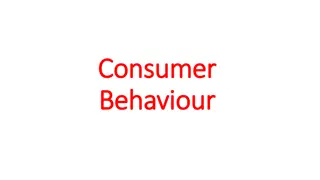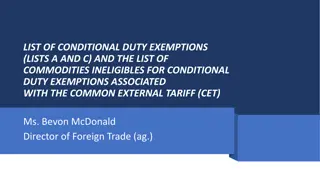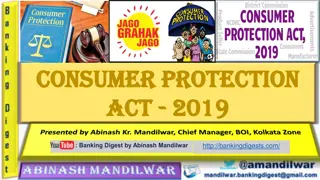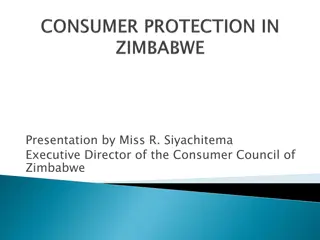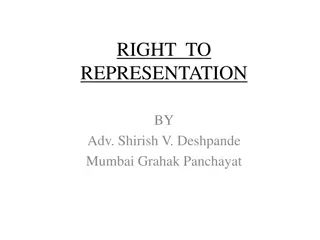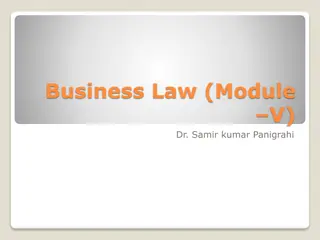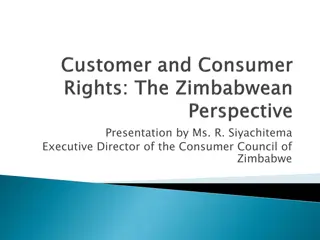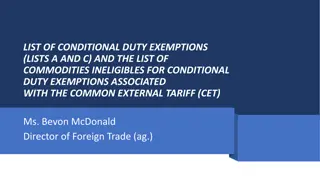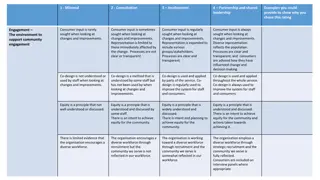The Consumer Duty Skills Toolkit
This informational content delves into the key elements of outcomes-based regulation, consumer understanding, and support under the Consumer Duty. It emphasizes effective communication, recognizing vulnerable customers, and working with behavioral biases in the realm of consumer interactions. The material provides insights on real-world applications, focusing on customer outcomes, understanding, and preferred communication channels.
Download Presentation

Please find below an Image/Link to download the presentation.
The content on the website is provided AS IS for your information and personal use only. It may not be sold, licensed, or shared on other websites without obtaining consent from the author.If you encounter any issues during the download, it is possible that the publisher has removed the file from their server.
You are allowed to download the files provided on this website for personal or commercial use, subject to the condition that they are used lawfully. All files are the property of their respective owners.
The content on the website is provided AS IS for your information and personal use only. It may not be sold, licensed, or shared on other websites without obtaining consent from the author.
E N D
Presentation Transcript
The Consumer Duty Skills Toolkit Part 1 by Jeff Heasman MABP, PGCert CELTA, LL.B (Hons), LL.M Certified Practitioner Member of the Academy of Modern Applied Psychology Member of the Association for Business Psychology linkedin.com/in/jeffheasman
Learning objectives By the end of the session, participants will be able to: identify the key requirements relating to consumer understanding and consumer support under the Consumer Duty. understand the key elements of outcomes-based regulation and skills necessary to evidence outcomes. implement a strategy to utilise the skills taught to remain on the right side of the new Consumer Duty
The skills toolkit Part 1 Communicating in a way that aids accessibility and understanding. Checking understanding to facilitate informed decision- making. Part 2 Recognising and dealing with vulnerable customers. Recognising and handling behavioural biases throughout the customer journey. Note: throughout the Consumer Duty the FCA make a very strong link between behavioural biases and vulnerable customers.
Working in the real world Principle 12 focus on the outcomes customers get, and act in a way that reflects how consumers actually behave and transact in the real world, better enabling them to access and assess relevant information, and to act to pursue their financial objectives.
Customer understanding Builds on Principle 7 (TCF): Communications must: meet the information needs be likely to be understood by customers intended to receive the communication facilitate informed decisions taking into account the characteristics of the customers intended to receive the communication
You must: ask them if they understand the information and have any further questions test, monitor and adapt communications to support understanding and good outcomes for customers
Communication channels It is important to respect the customer s preferred communication channel but also note Paragraph 8.28: A firm might also consider requiring customers to interact with the firm via another channel before making a decision such as buying a product or service, where the other channel is likely to facilitate a fuller consideration of important information.
Tailoring communication Paragraph 8.31 requires firms to take into account what they know, or could reasonably be expected to know, about the sophistication, financial capabilities and vulnerability of the intended recipients of the communications and tailor them to meet their information needs as appropriate.
Remember the real world? Paragraph 8.39: Firms may consider their communications to be understandable, but that may only reflect the views of those involved in the design and sign-off of their communications often legal, compliance and other financial services professionals.
Testing understanding Readability testing for standard communications. Paragraph 8.73: adopt a test and learn approach , adapting communications where appropriate with the aim of improving customer understanding to support good outcomes.
Customer support At the heart of this pillar is providing support that meets the needs of the customer. Paragraph 9.4: Under the consumer understanding outcome firms should communicate with customers in a way that equips them to make effective, timely and properly informed decisions. Under the consumer support outcome firms should enable customers to act on these decisions without facing unreasonable barriers. Particular focus on vulnerable customers. Paragraph 9.37 deals with representatives of vulnerable customers.
How does outcomes-based regulation work? Inputs Outputs Outcomes The skills / resources needed to achieve the outcomes. The activities to achieve the outcomes. What is to be achieved / what the client vales. The regulator sets the outcomes to be achieved. The firm has freedom in terms of the inputs and outputs to achieve the outcomes.
Communicating in a way that aids accessibility and understanding
Plain language is the key Plain language Simplicity Understanding Transparency Honesty Trust = = = = = = Simplicity Understanding Transparency Honesty Trust Customers www.comprehensible.co.uk
Step 1 Read & Understand It Yourself
How many people can honestly admit to having read and understood the entire policy/product documents? The duties of the broker/advisor/intermediary go beyond those of being a post box. Inconsistencies or ambiguities will be construed against the drafter.
Step 2 Don t Wear Legalese Goggles
Each policy will have definitions but If interpretation is the quest to discover what a reasonable man would have understood specific parties to have meant by the use of specific language in a specific situation at a specific time and place, how can that be affected by authority? Lord Hoffmann in Bank of Credit and Commerce International SA v Ali [2001] UKHL 8
Step 3 Remove the Junk & the Clunk
The due observance and fulfilment of the terms so far as they relate to anything to be done or complied with by the Insured and the truth of the statements and answers in the Proposal shall be conditions precedent to any liability of the Company to make any payment under this policy. Taken from Language on Trial by the Plain English Campaign
How do we remove the junk and clunk? Keep sentences short and avoid surplus words (in the event that). Avoid archaic words (herewith), couplets (unless and until) and jargon (condition precedent). Avoid ambiguity (shall). Avoid nominalisations (We shall only make a payment under this policy if / We will only pay under this policy if ).
Compound phrases as prescribed by in accordance with in the course of in the event that on behalf of provided that until such time as under by, under in, while, during if for if until
Archaic language - couplets alter or change cease and desist do and perform for and during the period of full and complete made and entered into order and direct save and except
Step 4 Lift the Fog
Think about accessibility as well as readability. Use lists where appropriate and limit cross- references (accessibility). Think about the hierarchy of information.
The due observance and fulfilment of the terms so far as they relate to anything to be done or complied with by the Insured and the truth of the statements and answers in the Proposal shall be conditions precedent to any liability of the Company to make any payment under this policy. Taken from Language on Trial by the Plain English Campaign
We will only pay under this Policy if: 1. you have kept to the terms of the Policy; and 2. the statements and answers in your Proposal are true. Taken from Language on Trial by the Plain English Campaign
Step 5 Enlighten
In other words You will truly enlighten the customer when you are able to do the following: read and understand the text. take notes of the main points. cover the original. remove the junk and the clunk think about how to restructure. check against the original.
The 5 steps 1. Read and understand the policy yourself. 2. Don t wear the legalese goggles. 3. Remove the junk and the clunk. 4. Lift the fog. 5. Enlighten.
Checking understanding to facilitate informed decision-making
Concept checking A skill taught to teachers during training, especially language teachers. An unobtrusive way of testing if someone has truly listened to, and understood, your advice. It is important to avoid questions such as: Do you have any questions for me? (and relying on no) Is that clear? Do you understand? (and relying on yes) Is there anything you didn t understand? (and relying on no) Think back to how you would typically respond to such questions at school.
Why is this important? Our legal and regulatory duties require us to ensure we have explained and the client has understood. The Consumer Duty: outcome based regulation. Regardless of the duties placed upon us, it is just good practice. It reduces the risk of any loss of trust or loyalty in the future. It reduces the risk of reputational damage.
Vulnerable customers October 2020: 53% of UK adults classified as being vulnerable. Vulnerability includes capability: low knowledge of financial matters and low literacy skills. Remember that the 2012 Act requires you to take into account the specific characteristics of the actual consumer.
The illusion of communication You must paraphrase complicated information and apply it to the customer s specific circumstances. In other words, what this means is The way this applies to your situation is Concept check to ensure understanding.
The 4 levels of communication 1. What I intended to say. 2. What I actually said. 3. What I think the other person understood. 4. What they actually understood.
Introducing SURE Summarise Understanding check Repeat (client s answer or repeat advice) Embed
Summarise The summary should have two parts: 1) A summary of the key points of the advice, in plain language. 2) An explanation of how it applies to the client s specific circumstances.
Understanding check It is at this point that the concept question is asked. You cannot test all of your advice but rather you need to test a cross-section. The following is important: Plan the questions ahead of the discussion. Don t use jargon/unfamiliar language. Ask one question at a time. Use a mix of closed questions and open/probing questions. A danger with closed questions is that they have a 50% chance of getting the answer right. Never use leading questions.
Repeat If the client answers correctly, acknowledge and repeat the advice. If the client doesn t answer correctly, repeat the advice and repeat the same concept checking question.
Embed This will occur naturally through the repetition and questioning. If you follow the S, U & R of SURE, you can be confident that the knowledge has been embedded in the client s mind and it has been understood.
A practical example The due observance and fulfilment of the terms so far as they relate to anything to be done or complied with by the Insured and the truth of the statements and answers in the Proposal shall be conditions precedent to any liability of the Company to make any payment under this policy. Taken from Language on Trial by the Plain English Campaign
Summarise The insurer will only pay if you keep to the terms of the policy and the statements and answers in your proposal are true. Understanding check Can the insurer refuse to pay if you don t keep to the terms of the policy? (closed) What will happen if the statements and answers in your proposal aren t true? (open) Repeat That s right, if the statements and answers in your proposal aren t true, the insurer may refuse to pay. or Unfortunately, that isn t correct. Together, let s look again at the term (use inclusive language and ask the question again). Embed Hey presto!
Summarise Some of the advantages of moving cash into bonds are x, y and z. Understanding check Is y one of the advantages of moving cash into bonds? (closed) Can you remind me of one of the advantages of moving cash into bonds? (open) Repeat That s right, one of the advantages of moving cash into bonds is y. or Unfortunately, that isn t correct. Together, let s look again at the advantages of moving cash into bonds (use inclusive language and ask the question again). Embed Hey presto!
Summary Without some form of unobtrusive testing we cannot be confident that the client has listened to, and understood, our advice. We need to prepare the questions we ask. The SURE technique will improve relationships and increase trust and loyalty.
Restatement of learning objectives During this session, we have: identified the key requirements relating to consumer understanding and consumer support under the Consumer Duty. understood the key elements of outcomes-based regulation and skills necessary to evidence outcomes. learnt how to implement a strategy to utilise the skills taught to remain on the right side of the new Consumer Duty
